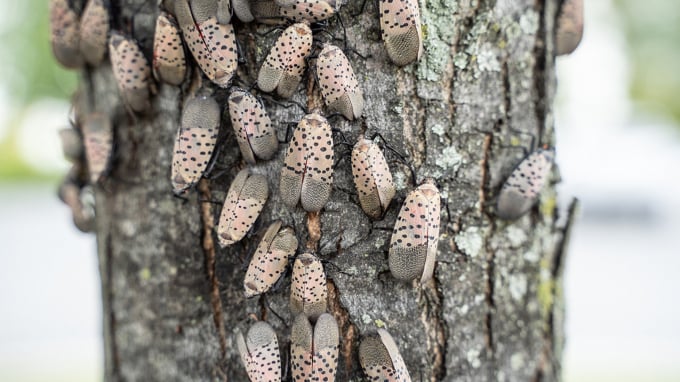May 20, 2025 | 00:48 GMT +7
May 20, 2025 | 00:48 GMT +7
Hotline: 0913.378.918
May 20, 2025 | 00:48 GMT +7
Hotline: 0913.378.918

Spotted Lanternfly (lycorma delicatula) infestations have caused Pennsylvania's Department of Agriculture to issue a quarantine invasive insect. Photo: iStock
The spotted lanternfly has been seen in New Jersey, New York, Pennsylvania and Indiana.
Rhode Island discovered the state's first specimen at the beginning of the month, state environmental officials said.
The winged pest, also known as Lycorma delicatula, is native to China.
It was first detected in Pennsylvania in 2014 but appeared to have already been present for two to three years prior, according to the USDA National Invasive Species Information Center.
It has also been found in Delaware, Maryland, Connecticut and Virginia, according to the New York State Department of Environmental Conservation (DEC).
The spotted lanternfly appears as big as a butterfly but with a moth-like appearance.
The Pennsylvania Department of Agriculture states that an adult is approximately 1 inch long and half an inch wide at rest, with tan, semi-transparent forewings, black spots, patches of red and black and a white band and yellow and black abdomen.
The spotted lanternfly's immature stages are black with white spots, and they develop the red patches as they mature.
Adults appear starting in July and in the fall adults lay 30 to 50 1-inch-long egg masses on tree trunks, firewood, rocks and vehicles.
The periodical cicadas in the eastern U.S. also laid their eggs in trees, so why is the spotted lanternfly "Public Enemy Number One?"
The USDA National Invasive Species Information Center says it poses a "serious economic threat to multiple U.S. industries."
The insect feeds on agricultural crops like grapes, apples and hops as well as maple, walnut and willow trees.
The Empire State says its presence could impact forests – making plants vulnerable to disease – and the agricultural and tourism industries.
New York's annual yield of apples and grapes – a combined value of $358.4 million – could be "greatly impacted" by infestations, the DEC said.
Signs of infestation include sap oozing from tree trunks; 1-inch-long, brownish-gray or brown and scaly egg masses; and honeydew build-up under plants. The lanternflies excrete honeydew, which encourages the growth of black sooty mold.
Multiple counties in Pennsylvania are now quarantined, the Pennsylvania Department of Agriculture said.
Reports show New Jersey's Somerset and Hunterdon counties are also under quarantine.
The message to people who believe they've seen these insects is clear: If you see something, say something…after you kill it.
"Kill it! Squash it, smash it...just get rid of it," the Pennsylvania Department of Agriculture instructed.
"If you see a Spotted Lanternfly, help us Stomp it Out," New Jersey's Department of Agriculture pleaded.
Officials also encourage all "SLF" spotters and killers to submit public reports using state websites to be able to better understand the spread of this species.
Somerset and Hunterdon counties are under quarantine.
It's not because of the COVID-19 bug, but because of a bug that's really a bug.
The infestation of the invasive spotted lanternfly has reached such a level in the two counties that the state Department of Agriculture has continued its quarantine to prevent the bug from spreading.
The state has coined a battle cry in the war against the invasive species – “Join the Battle, Beat the Bug.” The state is also encouraging residents to go on search-and-destroy missions.
"If you see a spotted lanternfly and are able to destroy it, please do so," state Department of Agriculture spokesperson Jerry Wolfe said. "Then go to www.badbug.nj.gov and click on the spotted lanternfly photo, and click on the Report a Sighting form, and fill that out."
The website also offers resource links to homeowners and business owners that include treatment options and information about the insect.
The lanternfly is an invasive planthopper native to China, India and Vietnam. It was first discovered in the United States in Berks County, Pennsylvania and has spread throughout the Keystone State and into New Jersey, Delaware, Maryland, Virginia, West Virginia, New York, Connecticut and Ohio.
While the spotted lanternfly does not bite or sting, it can harm many different kinds of plants by sucking on their sap.
The spotted lanternfly was first spotted in Hunterdon in 2018 and spread to Somerset in 2019, The numbers "skyrocketed" in 2020, George Hamilton, a professor of entomology at Rutgers, told the Master Gardeners of Somerset County in May.
Hamilton said the bug, about an inch long as adults, likes to feed on maples, black walnuts, trees of heaven, birches and willows. They also prefer wild grape vines...
(FoxNews: AP)

(VAN) Fourth most important food crop in peril as Latin America and Caribbean suffer from slow-onset climate disaster.

(VAN) Shifting market dynamics and the noise around new legislation has propelled Trouw Nutrition’s research around early life nutrition in poultry. Today, it continues to be a key area of research.

(VAN) India is concerned about its food security and the livelihoods of its farmers if more US food imports are allowed.

(VAN) FAO's Director-General emphasises the need to work together to transform agrifood systems.

(VAN) Europe is facing its worst outbreak of foot-and-mouth since the start of the century.

(VAN) The central authorities, in early April, released a 10-year plan for rural vitalization.

(VAN) Viterra marked a significant milestone in its carbon measurement program in Argentina, called Ígaris, reaching 1 million soybean hectares measured.